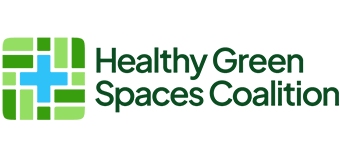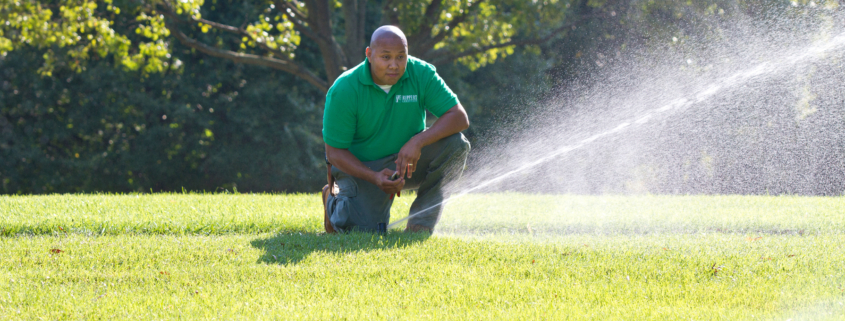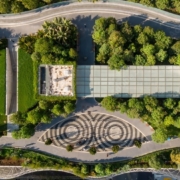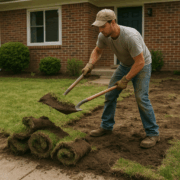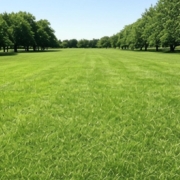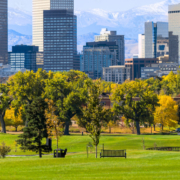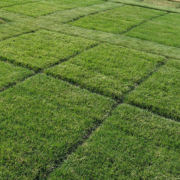Irrigation System Maintenance: The (Most) Cost Effective Way to Save Water
For many ornamental landscapes, the easiest path to water savings isn’t the addition of new irrigation technologies or the removal of turfgrass—it’s simply fixing what’s already there. Studies have shown that 30-60% of irrigation water is wasted, often due to leaks, broken sprinkler heads, poor pressure regulation, or improper irrigation scheduling (Kjelgren et al., 2000; Dukes et al., 2020). This level of waste certainly strains municipal water supplies, but it also increases utility bills and can harm plant health by applying water in excess of plant needs.
While innovations like smart controllers and low-water-use plants are often recommended, regular irrigation system maintenance is still one of the most cost-effective and underutilized strategies for reducing outdoor water use. Maintenance tasks—like adjusting sprinkler head spray patterns, checking for leaks, and updating irrigation schedules seasonally—require little to no investment, yet yield substantial water savings. Programs like the Utah State University Water Check Program, for example, have consistently demonstrated that simple adjustments to irrigation systems and proper irrigation scheduling reduce outdoor water use by 20-30% without sacrificing landscape quality (Aveek et al., 2023).
Research Highlights
- Fixing misaligned tilted and clogged sprinkler heads is one of the easiest ways to reduce water use.
- Setting your controller and smart controller appropriately are critical.
- Qualified Water Efficient Landscapers can be found at QWEL.net.
Regular irrigation system maintenance is simply a necessary task like changing the oil in a car. In both cases, efficiency, longevity, and improved operation are the goals. And in the case of irrigation system maintenance, water is saved, and plant health is improved.
The Hidden Water Waste in Landscapes
While some landscapes may be designed with water efficiency in mind, hidden water loss is still a big water waster in both residential and commercial irrigation systems. One of the most common culprits is over-irrigation, typically caused by systems running too frequently or for too long. Over-irrigation not only leads to water waste but also contributes to shallow rooting by plants, increased disease pressure, and poor overall plant health.
Water waste is frequently exacerbated by easily overlooked system issues including leaks, broken, tilted or misaligned sprinkler heads, overlapping irrigation zones, and poor scheduling. A single broken sprinkler head, for example, can waste hundreds of gallons of water per irrigation cycle, and overspray onto sidewalks or driveways creates water runoff that doesn’t benefit the landscape and can actually damage concrete and asphalt.
One thing we know for sure is that most landscape irrigation systems are leaking money and resources silently, underscoring the need for routine inspections and maintenance to ensure that water is applied where and when it’s needed most (EPA WaterSense™, 2025).
What Does Irrigation System Maintenance Actually Involve?
Effective irrigation system maintenance includes several simple tasks that can result in significant water savings and promote healthier landscape plants. For example, routine inspections can identify and correct common issues like misaligned, tilted, or clogged sprinkler heads and outdated irrigation controller settings. These may seem like minor issues, but they can lead to significant water loss and waste. A broken sprinkler head, for example, can waste up to 25,000 gallons of water annually (EPA WaterSense™, 2023). Therefore, cleaning out nozzles, ensuring proper sprinkler alignment, leveling sprinkler heads, and replacing damaged or broken system components can help restore efficient irrigation and reduce waste.
Seasonal maintenance is also critical. During spring start-up, for example, the system should be gradually pressurized, and each zone should be observed while operating for leaks or damage. Fall shutdown and winterization can also help prevent freezing damage to pipes and valves, reducing costly repairs and extending system life (Schaible et al., 2021).
Water pressure is another maintenance concern and is the biggest variable in irrigation systems. Too much water pressure causes misting, evaporation losses, and uneven water distribution, which all waste water and compromise plant health. Too little water pressure results in incomplete spray patterns and reduced uniformity which also waste water and compromise plant health. Related, studies have shown that pressure-regulating sprinkler bodies can significantly improve distribution uniformity and reduce runoff by moderating water pressure, especially when retrofitted into older systems (Solomon et al., 2007).
Proper zoning and irrigation scheduling also ensure that water is applied based on the specific needs of different landscape areas. Zones grouped by plant type and sun exposure, also known as hydrozones, allow for customized watering—reducing excess water in shaded areas and providing adequate moisture to sunny areas. This approach can improve irrigation efficiency by as much as 20% (St. Hilaire et al., 2008).
Together, these strategies underscore that maintenance—not just equipment upgrades—is essential for achieving meaningful water savings in urban landscapes.
What About Return On Investment?
Irrigation system maintenance is one of the most cost-effective water conservation strategies available to homeowners and communities. Unlike higher-cost investments like smart irrigation controllers or turfgrass removal, routine irrigation system maintenance requires little expense and can often be completed with basic tools and DIY knowledge.
Fixing a broken sprinkler, adjusting a tilted sprinkler head, or replacing a nozzle can each cost under $20, but may save hundreds to thousands of gallons of water per month depending on how many breaks are repaired (EPA WaterSense, 2023). These simple adjustments offer a high return on investment (ROI) by immediately improving distribution uniformity and reducing water loss, often with no need for new equipment.
Recognizing the value of irrigation system maintenance, many cities and municipalities now offer rebates and incentives for irrigation tune-ups, sprinkler nozzle replacement, and pressure regulation retrofits. For instance, the Southern Nevada Water Authority and Denver Water offer rebates to customers who participate in irrigation system checks or replace inefficient components as part of regular maintenance (Denver Water, 2025).
To sum up, irrigation system maintenance delivers water savings quickly and affordably, making it your best first step toward a more water-efficient and sustainable landscape.
Do You Need a Professional?
While most irrigation system maintenance can be handled by homeowners and landscape managers, combining DIY efforts with periodic professional services offers the most effective path to long-term water savings. Professional irrigation audits include specialized services such as distribution uniformity (DU) testing, pressure regulation assessment, and zone-by-zone evaluations to determine if the system water application matches plant water needs. You can identify a local professional with Qualified Water Efficient Landscaper certification at QWEL.net.
These assessments often identify inefficiencies that are difficult to detect during casual observation, such as uneven spray patterns or mismatched precipitation rates. For example, Solomon et al. (2007) demonstrated that improving DU through nozzle replacement and pressure adjustments could reduce water use while enhancing landscape performance.
Homeowners, however, play a crucial role in routine irrigation system care. Monthly walk-throughs of the landscape to check for leaks, misaligned heads, or broken components can prevent costly water waste. In addition, simple tasks like adjusting run times based on seasonal weather, cleaning clogged nozzles, and updating controller settings are easy and highly effective.
There are numerous training resources and tools to support both homeowners and professionals in irrigation system maintenance. The EPA WaterSense™ program, for example, offers homeowner-friendly guides and checklists, while many land-grant universities provide workshops, fact sheets, and even hands-on irrigation demonstrations. Local water utilities may also host free classes and offer rebates for tune-ups, controller upgrades, and smart irrigation installations.
By combining basic DIY tasks with professional expertise, homeowners and landscape managers can enhance irrigation efficiency, save money, and extend the life of their systems.
Conclusion
You don’t need to rip out your lawn or invest in costly new technologies to make a meaningful impact on your landscape water use—regular irrigation system maintenance is an easy and affordable way to conserve water. From tightening a loose sprinkler head to adjusting your irrigation controller’s schedule with the seasons, small actions can have big results in both water savings and landscape health.
Numerous studies and water audit programs have shown that simple fixes and system checks can reduce water use by 20-30%, all without changing plants or landscape design. Best of all, anyone can maintain an irrigation system whether you prefer a DIY approach or opt for a professional tune-up. Never assume your irrigation system is running efficiently, take a closer look. Walk through your yard, schedule a system audit, or create a seasonal maintenance plan because a well-tuned irrigation system is the first step toward a truly water-wise landscape.
Pre-Season Checklist
- Locate the manual for your irrigation controller and become familiar with its operation.
- Remove cobwebs and debris from irrigation controller cabinet and valve box. Replace the battery.
- Check all wiring connections for wear and breakage. Repair if necessary.
- Check the time/day settings on your controller to make sure they are correct.
- Set up your irrigation schedule. Contact your local cooperative Extension office for guidance.
- Before running the system, remove the last sprinkler head or the end caps on drips lines
- in each zone. Let the water run for 1–2 minutes to flush out dirt and debris. Repeat
- the flushing process for each irrigation zone. Replace the sprinkler heads and end caps.
- Make sure each irrigation zone has the same type of nozzles. Different nozzles have
- different precipitation rates which cause problems in the landscape.
- Check the placement of drip emitters. Emitters need to be at the edge of the root ball on new plantings and moved to the drip line (edge of foliage) of established plants.
- Walk through the monthly checklist below prior to the start of the irrigation season.
Monthly Checklist
- Turn on each irrigation zone monthly and look for sunken, broken, tilted or clogged heads and make necessary repairs.
- Observe the lowest head in each station for leaks or drainage. Install check valves where appropriate, or replace existing heads with heads that contain built-in check valves.
- Look for a very fine mist from spray heads caused by excessive pressure in the system. Correct the problem with a pressure regulator after the water meter or by installing pressure regulating sprinkler heads.
- Check to see if the sprinklers are covering the desired area uniformly. If your pressure is too low, try watering at a different time of day or modifying your system so there are fewer sprinklers on each valve.
- Consider adjusting the spray patterns or replacing nozzles if areas are not being covered thoroughly. Look for overspray of sprinklers onto sidewalks, driveways, and streets. The sprinklers’ spray patterns should either be adjusted or changed to a pattern that will stay within the planting area.
- Look for blocked spray patterns. Remove vegetation and other obstructions that may be blocking the spray or consider raising the heads.
- Check each head to see that it is at ground level. Raise sunken heads to grade or replace existing short pop-up heads in the lawn with taller pop-ups, as necessary. You can also trim around existing heads to avoid blocking the spray, but you will have to do this on a continual basis.
- Heads should be aligned vertically, except in sloped areas. In a sloped area, heads should be aligned perpendicular to the slope to achieve proper coverage. Tilted heads can cause ponding and uneven coverage.
- Check to see if you have head-to-head coverage between sprinklers. If necessary, consult a qualified professional to design a system with head-to-head spacing.
- Replace clogged drip emitters. If the system does not have a water filter, install one.
- Check for emitters that have popped off tubing because of high pressure. Install a pressure regulator on the valve for all drip stations.
- Check to see that all emitters are in place. Replace missing and broken emitters to keep your system running efficiently. Visit your local irrigation supply store for needed materials.
- Look for pinched or broken tubing and straighten or replace it. Visit your local irrigation supply store for needed materials.
- Make sure all tubing is attached to the appropriate emitters and that connections are secure.
Winterization
- Turn off the irritation water at the main water supply.
- Release pressure in each irrigation zone by turning on each valve.
- If applicable, open the drain valves. If you don’t have drain valves, use an air compressor to force excess water out of the irrigation lines. You may wish to have your irrigation system blown out by an irrigation professional. Consult your local irrigation supply store for a recommendation.
- Turn the irrigation controller to the off position.
References
Aveek, M., D.E. Rosenberg, C. Bastidas, J.S. Horsburgh, B.A. Lane, K. Kopp, P. Mayer and and J. Fazio. 2023. Increasing the Impact of Utah State University’s Extension Water Check Program With 5-Second Metering. Reports. Paper 681. https://digitalcommons.usu.edu/water_rep/681.
Denver Water. 2025. Residential Rebates. Denver Water. Retrieved 4/9/25. https://www.denverwater.org/residential/rebates-and-conservation-tips/residential-rebates?utm_source=chatgpt.com.
Dukes, M.D., J.M.S. Scholberg and J.W. Jones. 2020. Soil moisture sensor irrigation control for maintaining landscape water use efficiency. Applied Engineering in Agriculture 36(3):353-362.
Kjelgren, R., L. Rupp and D. Kilgren. 2000. Water conservation in urban landscapes. HortScience 35(6):1037-1040.
EPA WaterSense. 2023. Outdoor water use in the United States. U.S. Environmental Protection Agency. Retrieved 4/9/25. https://19january2017snapshot.epa.gov/www3/watersense/pubs/outdoor.html.
EPA WaterSense. 2025. Statistics and facts. U.S. Environmental Protection Agency. Retrieved 4/9/25. https://www.epa.gov/watersense/statistics-and-facts?utm_source=chatgpt.com.
Schaible, C., K. Kopp and J. Hoover. 2021. Irrigation system maintenance. Utah State University Extension. Retrieved 4/9/25. https://extension.usu.edu/yardandgarden/research/irrigation-system-maintenance?utm_source=chatgpt.com.
Solomon, K.H., J.A. Kissinger, G.P. Farrens and J.E. Borneman. 2007. Performance and water conservation potential of multi-stream, multi-trajectory rotating sprinklers for landscape irrigation. Applied Engineering in Agriculture 23(2):153-163.
St. Hilaire, R., M.A. Arnold, D.C. Wilkerson, D.A. Devitt, B.H. Hurd, B.J. Lesikar, B. J., V.I. Lohr, C. Martin, G.V. McDonald, R.L. Morris, D.R. Pittenger, D.A. Shaw and D.F. Zoldoske. 2008. Efficient water use in residential urban landscapes. HortScience 43(7):2081-2092.
